trailer OPEL COMBO 2010 Owners Manual
[x] Cancel search | Manufacturer: OPEL, Model Year: 2010, Model line: COMBO, Model: OPEL COMBO 2010Pages: 212, PDF Size: 2.49 MB
Page 92 of 212
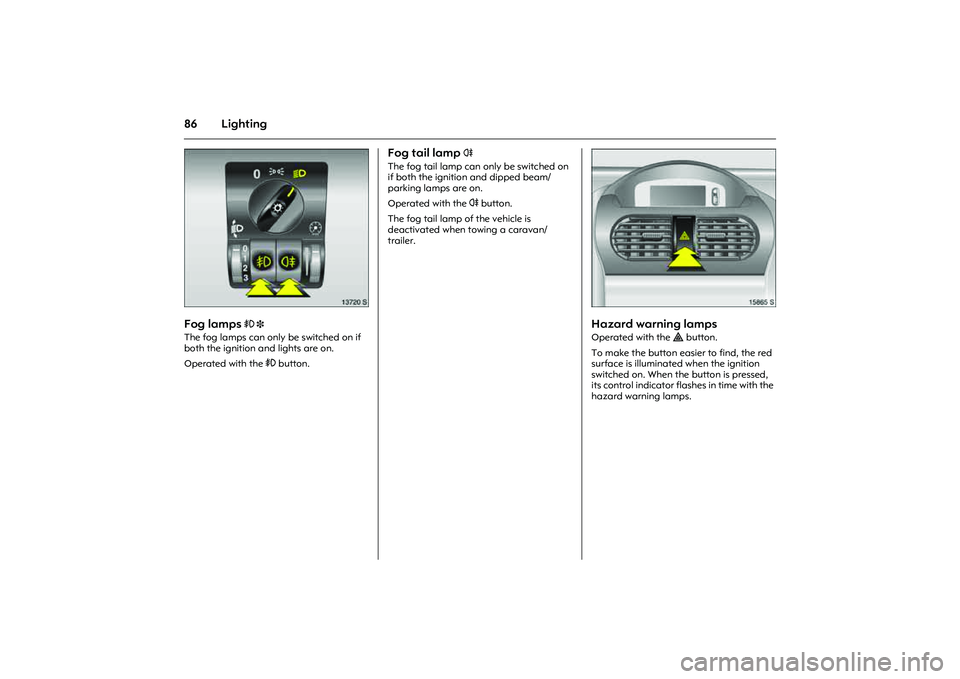
86 Lighting
Picture no: 13720s.tif
Fog lamps
> 3
The fog lamps can only be switched on if
both the ignition and lights are on.
Operated with the > button.
Fog tail lamp
r
The fog tail lamp can only be switched on
if both the ignition and dipped beam/
parking lamps are on.
Operated with the r button.
The fog tail lamp of the vehicle is
deactivated when towing a caravan/
trailer.
Picture no: 15865s.tif
Hazard warning lamps Operated with the ¨ button.
To make the button easier to find, the red
surface is illuminated when the ignition
switched on. When the button is pressed,
its control indicator flashes in time with the
hazard warning lamps.
Page 106 of 212
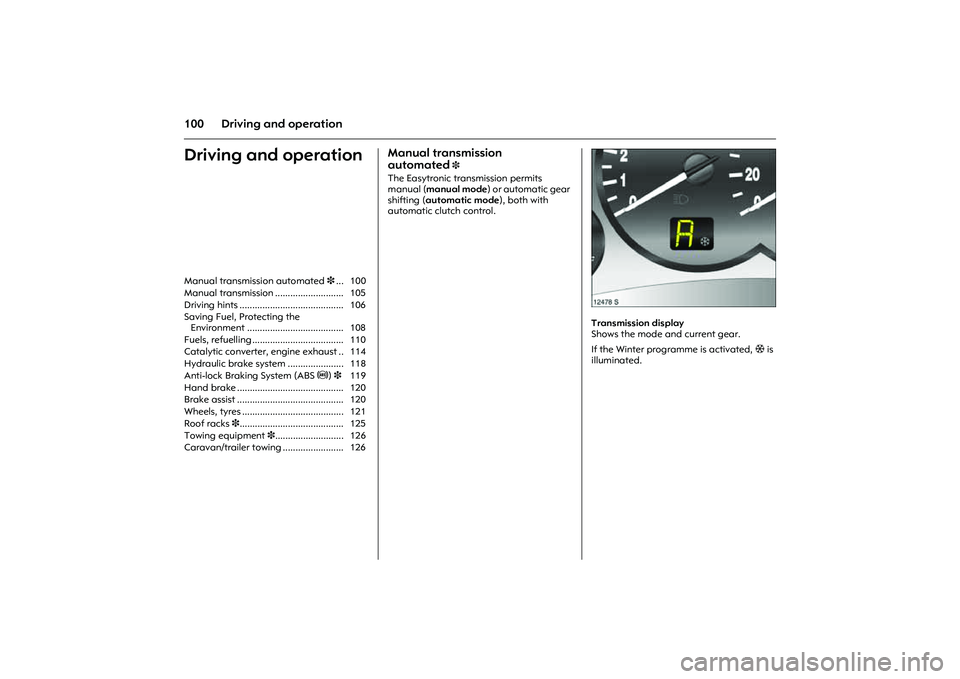
100 Driving and operationDriving and operation
Manual transmission
automated
3
The Easytronic transmission permits
manual (manual mode) or automatic gear
shifting (automatic mode), both with
automatic clutch control.
Picture no: 12478s.tif
Transmission display
Shows the mode and current gear.
If the Winter programme is activated, T is
illuminated. Manual transmission automated3... 100
Manual transmission ........................... 105
Driving hints ......................................... 106
Saving Fuel, Protecting the
Environment ...................................... 108
Fuels, refuelling .................................... 110
Catalytic converter, engine exhaust .. 114
Hydraulic brake system ...................... 118
Anti-lock Braking System (ABSu)3 119
Hand brake .......................................... 120
Brake assist .......................................... 120
Wheels, tyres ........................................ 121
Roof racks 3......................................... 125
Towing equipment 3........................... 126
Caravan/trailer towing ........................ 126
Page 108 of 212
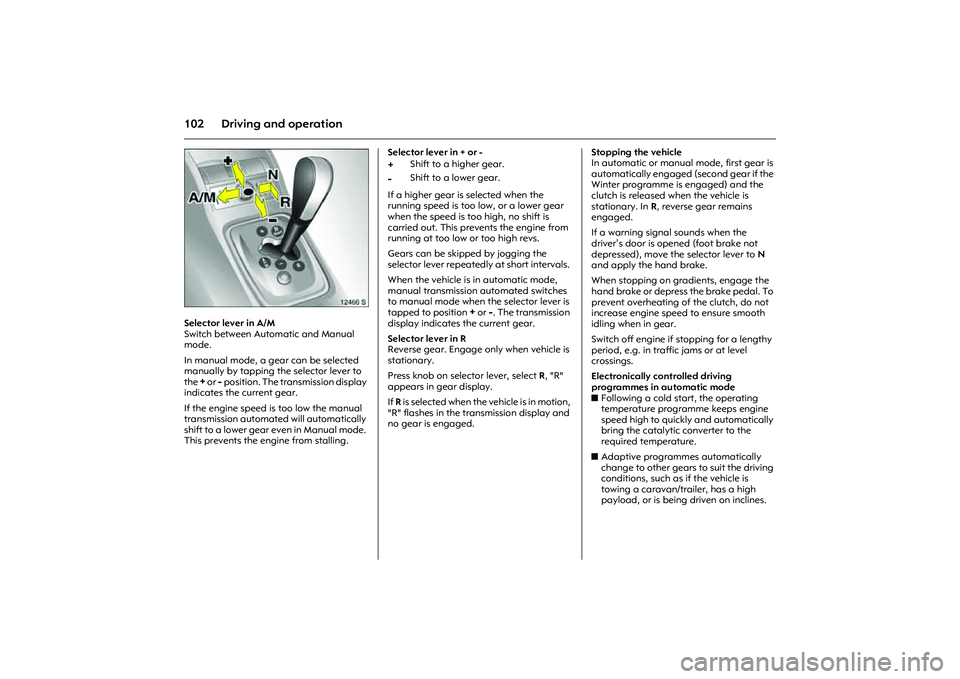
102 Driving and operation
Picture no: 12466s.tif
Selector lever in A/M
Switch between Automatic and Manual
mode.
In manual mode, a gear can be selected
manually by tapping the selector lever to
the
+ or
- position. The transmission display
indicates the current gear.
If the engine speed is too low the manual
transmission automated will automatically
shift to a lower gear even in Manual mode.
This prevents the engine from stalling. Selector lever in + or -
If a higher gear is selected when the
running speed is too low, or a lower gear
when the speed is too high, no shift is
carried out. This prevents the engine from
running at too low or too high revs.
Gears can be skipped by jogging the
selector lever repeatedly at short intervals.
When the vehicle is in automatic mode,
manual transmission automated switches
to manual mode when the selector lever is
tapped to position
+ or
-. The transmission
display indicates the current gear.
Selector lever in R
Reverse gear. Engage only when vehicle is
stationary.
Press knob on selector lever, select R, "R"
appears in gear display.
If R is selected when the vehicle is in motion,
"R" flashes in the transmission display and
no gear is engaged. Stopping the vehicle
In automatic or manual mode, first gear is
automatically engaged (second gear if the
Winter programme is engaged) and the
clutch is released when the vehicle is
stationary. In R, reverse gear remains
engaged.
If a warning signal sounds when the
driver’s door is opened (foot brake not
depressed), move the selector lever to N
and apply the hand brake.
When stopping on gradients, engage the
hand brake or depress the brake pedal. To
prevent overheating of the clutch, do not
increase engine speed to ensure smooth
idling when in gear.
Switch off engine if stopping for a lengthy
period, e.g. in traffic jams or at level
crossings.
Electronically controlled driving
programmes in automatic mode
zFollowing a cold start, the operating
temperature programme keeps engine
speed high to quickly and automatically
bring the catalytic converter to the
required temperature.
zAdaptive programmes automatically
change to other gears to suit the driving
conditions, such as if the vehicle is
towing a caravan/trailer, has a high
payload, or is being driven on inclines.
+
Shift to a higher gear.
-
Shift to a lower gear.
Page 112 of 212
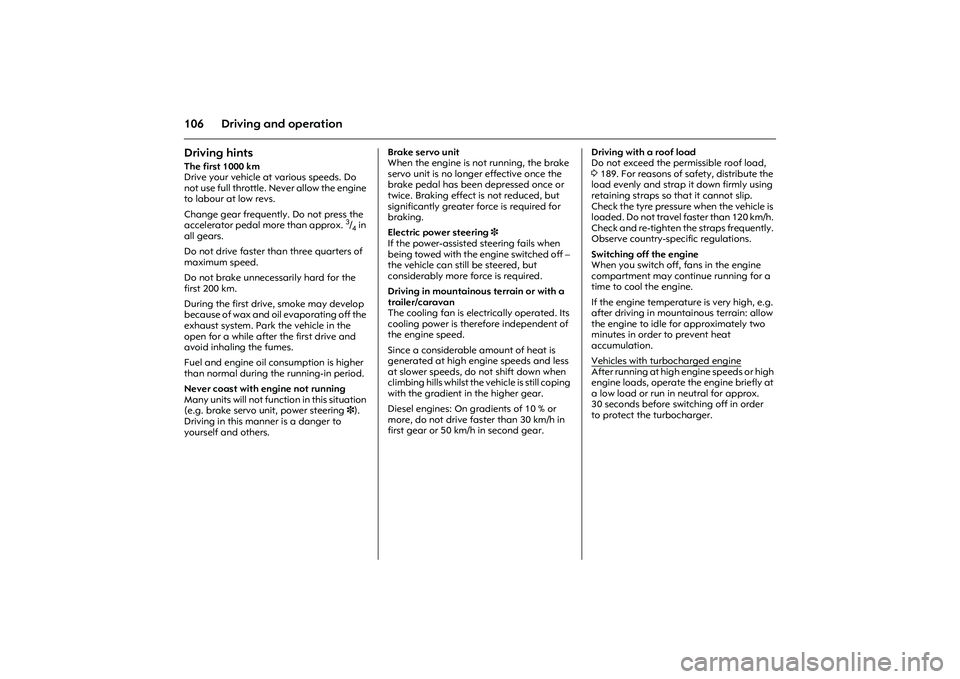
106 Driving and operationDriving hints The first 1000 km
Drive your vehicle at various speeds. Do
not use full throttle. Never allow the engine
to labour at low revs.
Change gear frequently. Do not press the
accelerator pedal more than approx.
3/4 in
all gears.
Do not drive faster than three quarters of
maximum speed.
Do not brake unnecessarily hard for the
first 200 km.
During the first drive, smoke may develop
because of wax and oil evaporating off the
exhaust system. Park the vehicle in the
open for a while after the first drive and
avoid inhaling the fumes.
Fuel and engine oil consumption is higher
than normal during the running-in period.
Never coast with engine not running
Many units will not function in this situation
(e.g. brake servo unit, power steering3).
Driving in this manner is a danger to
yourself and others. Brake servo unit
When the engine is not running, the brake
servo unit is no longer effective once the
brake pedal has been depressed once or
twice. Braking effect is not reduced, but
significantly greater force is required for
braking.
Electric power steering 3
If the power-assisted steering fails when
being towed with the engine switched off –
the vehicle can still be steered, but
considerably more force is required.
Driving in mountainous terrain or with a
trailer/caravan
The cooling fan is electrically operated. Its
cooling power is therefore independent of
the engine speed.
Since a considerable amount of heat is
generated at high engine speeds and less
at slower speeds, do not shift down when
climbing hills whilst the vehicle is still coping
with the gradient in the higher gear.
Diesel engines: On gradients of 10 % or
more, do not drive faster than 30 km/h in
first gear or 50 km/h in second gear. Driving with a roof load
Do not exceed the permissible roof load,
3189. For reasons of safety, distribute the
load evenly and strap it down firmly using
retaining straps so that it cannot slip.
Check the tyre pressure when the vehicle is
loaded. Do not travel faster than 120 km/h.
Check and re-tighten the straps frequently.
Observe country-specific regulations.
Switching off the engine
When you switch off, fans in the engine
compartment may continue running for a
time to cool the engine.
If the engine temperature is very high, e.g.
after driving in mountainous terrain: allow
the engine to idle for approximately two
minutes in order to prevent heat
accumulation.
Vehicles with turbocharged engine
After running at high engine speeds or high
engine loads, operate the engine briefly at
a low load or run in neutral for approx.
30 seconds before switching off in order
to protect the turbocharger.
Page 120 of 212
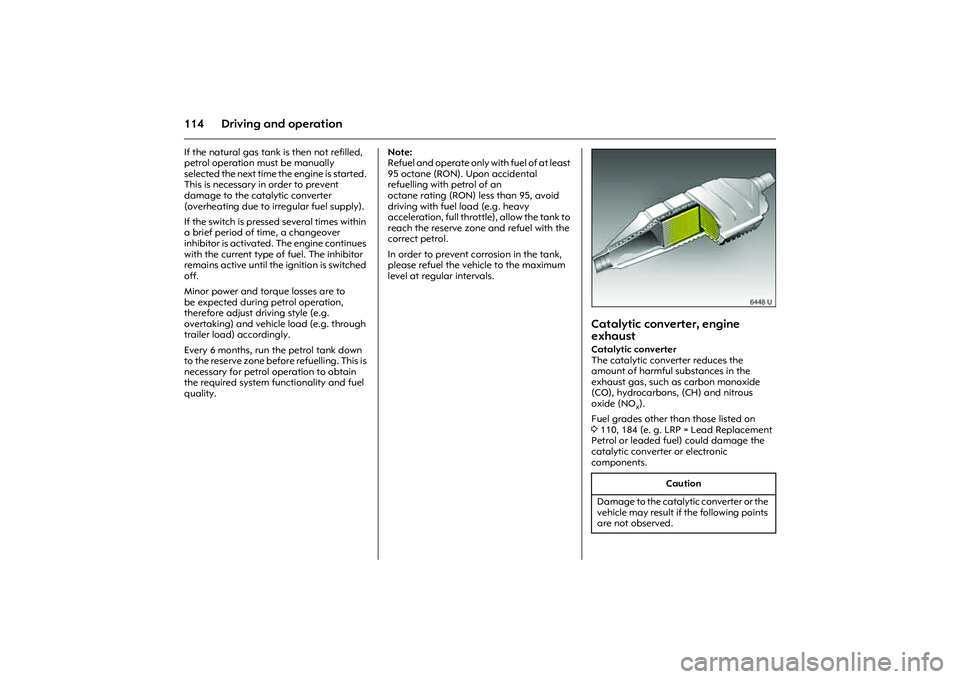
114 Driving and operationIf the natural gas tank is then not refilled,
petrol operation must be manually
selected the next time the engine is started.
This is necessary in order to prevent
damage to the catalytic converter
(overheating due to irregular fuel supply).
If the switch is pressed several times within
a brief period of time, a changeover
inhibitor is activated. The engine continues
with the current type of fuel. The inhibitor
remains active until the ignition is switched
off.
Minor power and torque losses are to
be expected during petrol operation,
therefore adjust driving style (e.g.
overtaking) and vehicle load (e.g. through
trailer load) accordingly.
Every 6 months, run the petrol tank down
to the reserve zone before refuelling. This is
necessary for petrol operation to obtain
the required system functionality and fuel
quality.Note:
Refuel and operate only w i t h f u e l o f a t l e a s t
95 octane (RON). Upon accidental
refuelling with petrol of an
octane rating (RON) less than 95, avoid
driving with fuel load (e.g. heavy
acceleration, full throttle), allow the tank to
reach the reserve zone and refuel with the
correct petrol.
In order to prevent corrosion in the tank,
please refuel the vehicle to the maximum
level at regular intervals.
Picture no: 6448u.tif
Catalytic converter, engine
exhaust Catalytic converter
The catalytic converter reduces the
amount of harmful substances in the
exhaust gas, such as carbon monoxide
(CO), hydrocarbons, (CH) and nitrous
oxide (NO
x).
Fuel grades other than those listed on
3110, 184 (e. g. LRP = Lead Replacement
Petrol or leaded fuel) could damage the
catalytic converter or electronic
components.
Caution
Damage to the catalytic converter or the
vehicle may result if the following points
are not observed.
Page 132 of 212
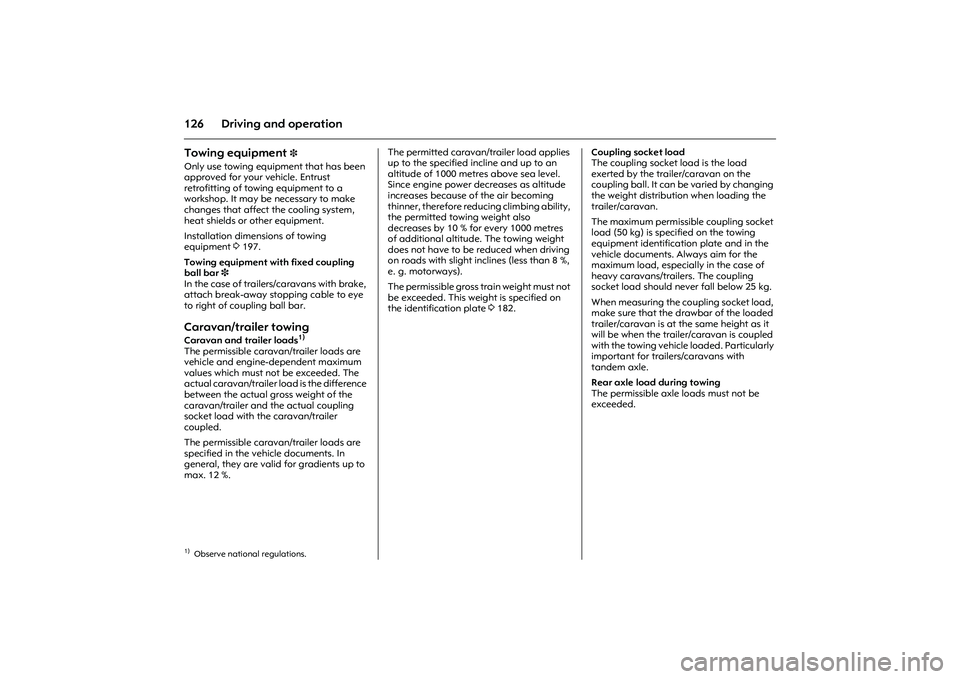
126 Driving and operationTowing equipment
3
Only use towing equipment that has been
approved for your vehicle. Entrust
retrofitting of towing equipment to a
workshop. It may be necessary to make
changes that affect the cooling system,
heat shields or other equipment.
Installation dimensions of towing
equipment 3197.
Towing equipment with fixed coupling
ball bar3
In the case of trailers/caravans with brake,
attach break-away stopping cable to eye
to right of coupling ball bar. Caravan/trailer towingCaravan and trailer loads
1)
The permissible caravan/trailer loads are
vehicle and engine-dependent maximum
values which must not be exceeded. The
actual caravan/trailer load is the difference
between the actual gross weight of the
caravan/trailer and the actual coupling
socket load with the caravan/trailer
coupled.
The permissible caravan/trailer loads are
specified in the vehicle documents. In
general, they are valid for gradients up to
max. 12 %. The permitted caravan/trailer load applies
up to the specified incline and up to an
altitude of 1000 metres above sea level.
Since engine power decreases as altitude
increases because of the air becoming
thinner, therefore reducing climbing ability,
the permitted towing weight also
decreases by 10 % for every 1000 metres
of additional altitude. The towing weight
does not have to be reduced when driving
on roads with slight inclines (less than 8 %,
e. g. motorways).
The permissible gross train weight must not
be exceeded. This weight is specified on
the identification plate 3182. Coupling socket load
The coupling socket load is the load
exerted by the trailer/caravan on the
coupling ball. It can be varied by changing
the weight distribution when loading the
trailer/caravan.
The maximum permissible coupling socket
load (50 kg) is specified on the towing
equipment identification plate and in the
vehicle documents. Always aim for the
maximum load, especially in the case of
heavy caravans/trailers. The coupling
socket load should never fall below 25 kg.
When measuring the coupling socket load,
make sure that the drawbar of the loaded
trailer/caravan is at the same height as it
will be when the trailer/caravan is coupled
with the towing vehicle loaded. Particularly
important for trailers/caravans with
tandem axle.
Rear axle load during towing
The permissible axle loads must not be
exceeded. 1)Observe national regulations.
Page 133 of 212

127
Driving and operation
Picture no: 13228s.tif
Driving characteristics, towing tips
In the case of trailers/caravans with brakes,
attach breakaway stopping cable to eye.
Before attaching the trailer/caravan,
lubricate the ball of the trailer/caravan
towing device. However, do not lubricate
the ball if a stabiliser, which acts on the
coupling ball, is being used to damp
hunting.
Check caravan/trailer lighting before
starting to drive. The fog tail lamps on the
vehicle are deactivated when towing a
caravan or trailer. Caravans/trailers with LED turn signals
require a provision that make bulb
replacement as with standard bulbs
possible.
Handling is greatly influenced by the
loading of the trailer/caravan. Loads
should therefore be secured so that they
cannot slip and be placed in the centre of
the trailer/caravan if possible, i.e. above
the axle.
In the case of trailers with low driving
stability, do not exceed a speed of
80 km/h; the use of a friction-type
stabiliser is highly recommended.
If the trailer/caravan starts to sway, drive
more slowly, do not attempt to correct the
steering and brake sharply if necessary.
If it is necessary to apply the brakes fully,
depress the brake pedal as hard as
possible.
Remember that the braking distance for
vehicles towing caravans/trailers with and
without brake is always greater than that
for vehicles not towing a caravan/trailer. When driving downhill, drive in the same
gear as if driving uphill and drive at a
similar speed.
Adjust tyre pressure to the value specified
for full load 3121, 3191.
Page 177 of 212
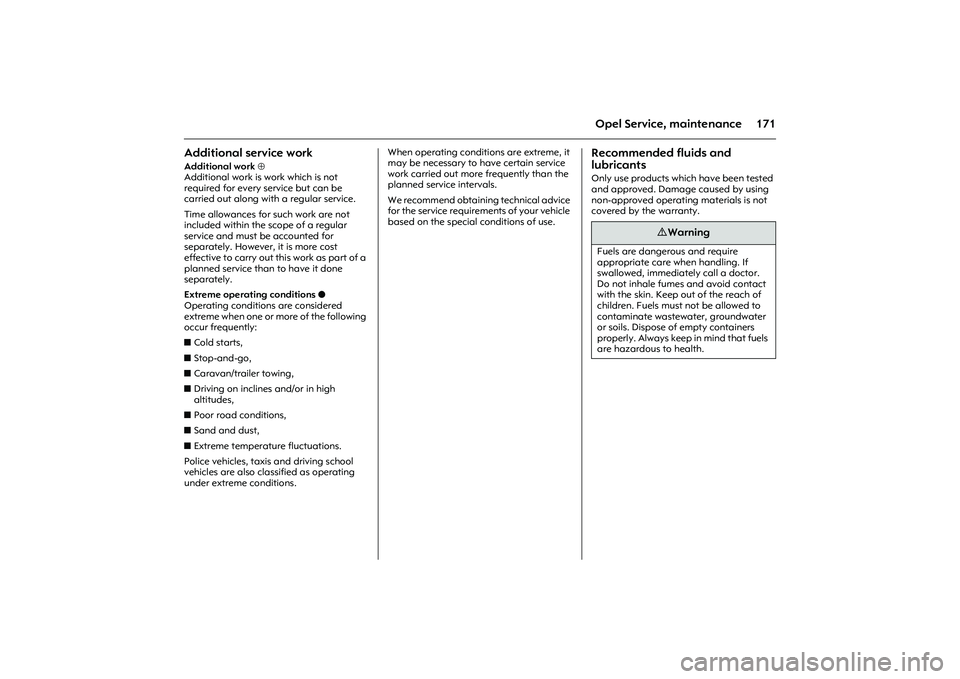
171
Opel Service, maintenance
Additional service workAdditional work ⊕
Additional work is work which is not
required for every service but can be
carried out along with a regular service.
Time allowances for such work are not
included within the scope of a regular
service and must be accounted for
separately. However, it is more cost
effective to carry out this work as part of a
planned service than to have it done
separately.
Extreme operating conditions o
Operating conditions are considered
extreme when one or more of the following
occur frequently:
zCold starts,
zStop-and-go,
zCaravan/trailer towing,
zDriving on inclines and/or in high
altitudes,
zPoor road conditions,
zSand and dust,
zExtreme temperature fluctuations.
Police vehicles, taxis and driving school
vehicles are also classified as operating
under extreme conditions.When operating conditions are extreme, it
may be necessary to have certain service
work carried out more frequently than the
planned service intervals.
We recommend obtaining technical advice
for the service requirements of your vehicle
based on the special conditions of use.
Recommended fluids and
lubricants Only use products which have been tested
and approved. Damage caused by using
non-approved operating materials is not
covered by the warranty.
9 Warning
Fuels are dangerous and require
appropriate care when handling. If
swallowed, immediately call a doctor.
Do not inhale fumes and avoid contact
with the skin. Keep out of the reach of
children. Fuels must not be allowed to
contaminate wastewater, groundwater
or soils. Dispose of empty containers
properly. Always keep in mind that fuels
are hazardous to health.
Page 195 of 212
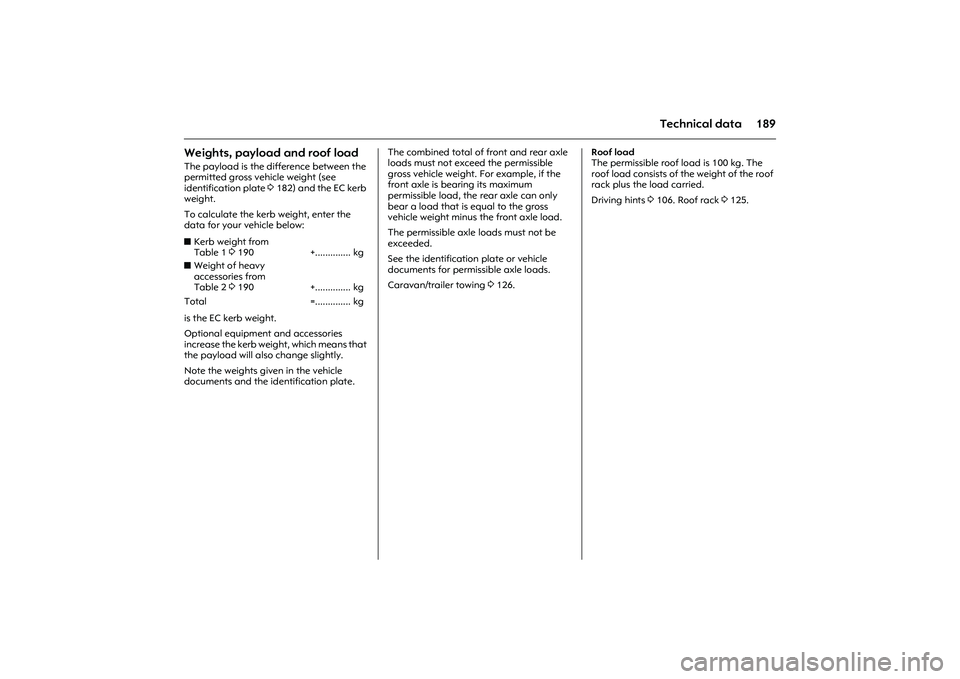
189
Technical data
Weights, payload and roof load The payload is the difference between the
permitted gross vehicle weight (see
identification plate 3182) and the EC kerb
weight.
To calculate the kerb weight, enter the
data for your vehicle below:
is the EC kerb weight.
Optional equipment and accessories
increase the kerb weight, which means that
the payload will also change slightly.
Note the weights given in the vehicle
documents and the identification plate. The combined total of front and rear axle
loads must not exceed the permissible
gross vehicle weight. For example, if the
front axle is bearing its maximum
permissible load, the rear axle can only
bear a load that is equal to the gross
vehicle weight minus the front axle load.
The permissible axle loads must not be
exceeded.
See the identification plate or vehicle
documents for permissible axle loads.
Caravan/trailer towing 3126. Roof load
The permissible roof load is 100 kg. The
roof load consists of the weight of the roof
rack plus the load carried.
Driving hints 3106. Roof rack 3125.
zKerb weight from
Table 1 3190 +.............. kg
zWeight of heavy
accessories from
Table 2 3190 +.............. kg
Total =.............. kg
Page 203 of 212
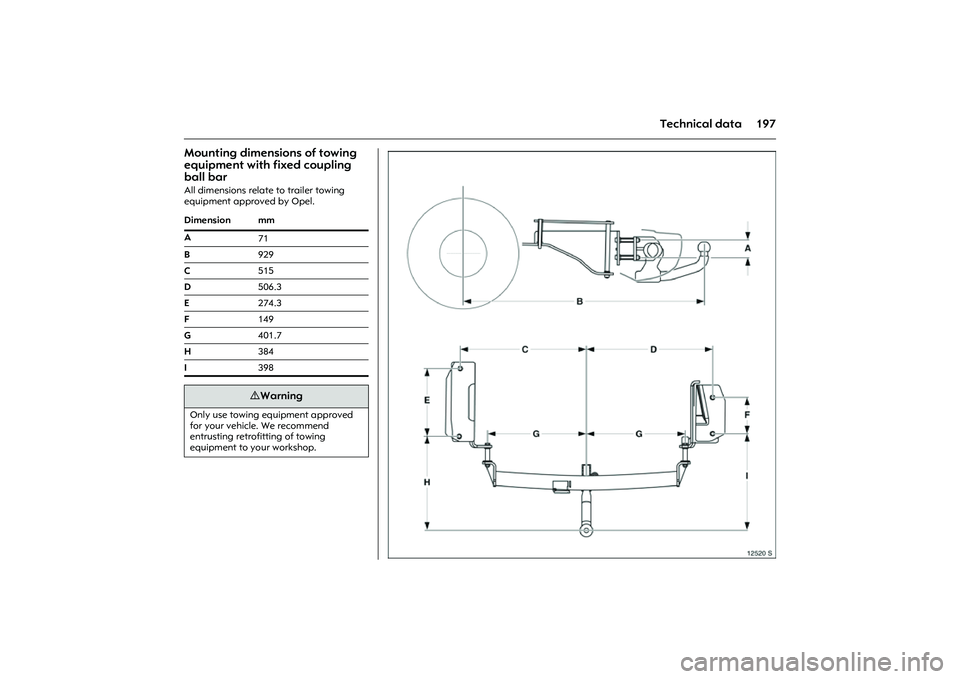
197 Technical data
Mounting dimensions of towing
equipment with fixed coupling
ball bar All dimensions relate to trailer towing
equipment approved by Opel.
Dimension mm
A
71
B929
C515
D506.3
E274.3
F149
G401.7
H384
I398
9 Warning
Only use towing equipment approved
for your vehicle. We recommend
entrusting retrofitting of towing
equipment to your workshop.